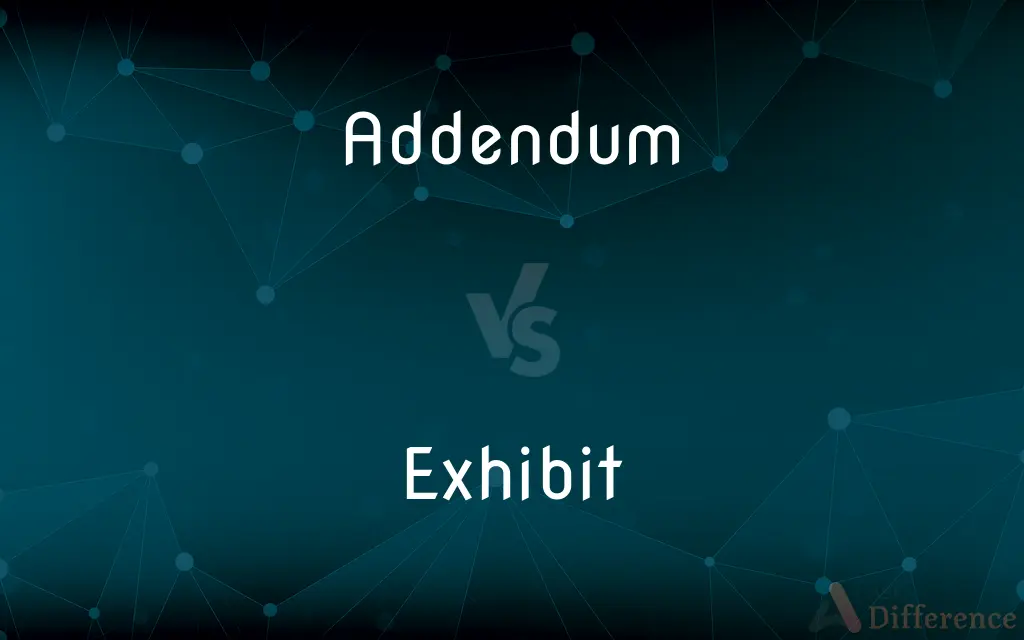Addendum vs. Exhibit — What's the Difference?
By Urooj Arif & Fiza Rafique — Updated on March 27, 2024
An addendum is an addition to a document to include extra information, while an exhibit is a document or item used as evidence in legal proceedings or displayed for public viewing.

Difference Between Addendum and Exhibit
Table of Contents
ADVERTISEMENT
Key Differences
An addendum is typically used to add information to a document after it has been completed, often to include details that were omitted or have become relevant after the document's initial creation. It is a formal way to make amendments without altering the original document, ensuring that all parties are aware of the additional details. On the other hand, an exhibit refers to documents, objects, or other items that are presented as evidence in court, or items displayed in a museum, gallery, or public show. Exhibits are used to support claims, provide proof, or enhance understanding of a subject matter.
While an addendum modifies or adds to the content of a document, making it part of the official record or agreement, an exhibit serves as a standalone piece of evidence or an item for display that is referenced within a document or proceeding. An addendum is integrated into the structure of a document, often referenced in the original content, whereas an exhibit is usually presented separately but linked to the main document or case through citations or labels.
The purpose of an addendum is to clarify, update, or expand the information within a document to ensure it remains accurate and comprehensive. Exhibits, however, are utilized to illustrate, prove, or provide a visual or tangible reference to support the content of a document or argument in a legal or public setting.
In legal contexts, both addendums and exhibits are important; addendums can alter or add to the legal terms of agreements or contracts, while exhibits can play a crucial role in proving facts or claims in court. In artistic or educational settings, exhibits aim to engage, educate, or entertain the public, offering a tangible or visual representation of a concept, artwork, or historical item.
The use of these terms highlights the formal procedures in documentation and legal practices, emphasizing the importance of detail, evidence, and clarity in conveying and proving information. Whether altering the content of a document through an addendum or providing evidence or display through an exhibit, both serve critical roles in their respective fields.
ADVERTISEMENT
Comparison Chart
Definition
An addition made to a document to include extra information
A document or item used as evidence or displayed publicly
Purpose
To update, clarify, or expand a document
To serve as evidence or for public viewing
Context
Often used in contracts, agreements, and official records
Used in legal proceedings, museums, and galleries
Relation to Original Document
Integrated into and modifies the original document
Standalone but referenced or cited in the main document
Usage
To ensure a document remains accurate and comprehensive
To illustrate, prove, or provide a reference
Compare with Definitions
Addendum
Additional information added to a book or publication.
The author included an addendum with updated research.
Exhibit
A supporting document in a research paper or presentation.
The statistical data was included as an exhibit to support the study's conclusions.
Addendum
A supplementary addition to a document.
The contract's addendum outlined the new terms agreed upon by both parties.
Exhibit
A document or object used as evidence in court.
The photograph served as an exhibit in the trial.
Addendum
Extension of a previous agreement or statement.
The treaty's addendum clarified the roles and responsibilities of each nation.
Exhibit
Evidence presented for public viewing or consideration.
The company's latest product prototype was the main exhibit at the trade show.
Addendum
An appendix or supplement to a document.
The legal document came with an addendum specifying additional conditions.
Exhibit
Something shown or displayed to illustrate a point.
The instructor used the model as an exhibit during the lecture.
Addendum
An amendment to include omitted details.
An addendum was added to the report to include the latest findings.
Exhibit
An item displayed in a museum or gallery.
The ancient manuscript was a popular exhibit at the museum.
Addendum
An addendum or appendix, in general, is an addition required to be made to a document by its author subsequent to its printing or publication. It comes from the Latin gerundive addendum, plural addenda, "that which is to be added," from addere (lit. ''give toward'', compare with memorandum, agenda, corrigenda).
Exhibit
To show outwardly; display
Exhibited pleasure by smiling.
Addendum
An item of additional material added at the end of a book or other publication.
Exhibit
To present for others to see
Rolled up his sleeve to exhibit the scar.
Addendum
The radial distance from the pitch circle of a cogwheel or wormwheel to the crests of the teeth or ridges.
Exhibit
To present in a public exhibition or contest
Exhibited her paintings at a gallery.
Addendum
Something added or to be added, especially a supplement to a book.
Exhibit
To give evidence or an instance of; demonstrate
Young musicians eager to exhibit their talent.
A plant that exhibits dimorphism.
Addendum
Something to be added; especially text added as an appendix or supplement to a document.
Exhibit
To put something on public display.
Addendum
A postscript.
Exhibit
A public showing; an exhibition
Spent the afternoon at the art exhibit.
Addendum
(engineering) The height by which the tooth of a gear projects beyond (outside for external, or inside for internal) the standard pitch circle or pitch line.
Exhibit
Something exhibited
Each exhibit in the show took hours to assemble.
Addendum
A thing to be added; an appendix or addition.
Exhibit
(Law) Something marked for identification with the purpose of being introduced as evidence
Referred to Exhibit A.
Addendum
Textual matter that is added onto a publication; usually at the end
Exhibit
(Informal) Something used as an example, as when arguing or making a point
You never do your chores—Exhibit A.
Exhibit
(transitive) To display or show (something) for others to see, especially at an exhibition or contest.
He wanted to exhibit his baseball cards.
Exhibit
(transitive) To demonstrate.
The players exhibited great skill.
Exhibit
(intransitive) To put on a public display.
Will you be exhibiting this year?
Exhibit
(medicine) To administer as a remedy.
To exhibit calomel
Exhibit
An instance of exhibiting.
Exhibit
That which is exhibited.
Exhibit
A public showing; an exhibition.
The museum's new exhibit is drawing quite a crowd.
Exhibit
(legal) An article formally introduced as evidence in a court.
Exhibit A is this photograph of the corpse.
Exhibit
To hold forth or present to view; to produce publicly, for inspection; to show, especially in order to attract notice to what is interesting; to display; as, to exhibit commodities in a warehouse, a picture in a gallery.
Exhibiting a miserable example of the weakness of mind and body.
Exhibit
To submit, as a document, to a court or officer, in course of proceedings; also, to present or offer officially or in legal form; to bring, as a charge.
He suffered his attorney-general to exhibit a charge of high treason against the earl.
Exhibit
To administer as a remedy; as, to exhibit calomel.
Exhibit
Any article, or collection of articles, displayed to view, as in an industrial exhibition; a display; as, this exhibit was marked A; the English exhibit.
Exhibit
A document produced and identified in court for future use as evidence.
Exhibit
An object or statement produced before a court of law and referred to while giving evidence
Exhibit
Something shown to the public;
The museum had many exhibits of oriental art
Exhibit
Show an attribute, property, knowledge, or skill;
He exhibits a great talent
Exhibit
To show, make visible or apparent;
The Metropolitan Museum is exhibiting Goya's works this month
Why don't you show your nice legs and wear shorter skirts?
National leaders will have to display the highest skills of statesmanship
Exhibit
Show or demonstrate something to an interested audience;
She shows her dogs frequently
We will demo the new software in Washington
Exhibit
Walk ostentatiously;
She parades her new husband around town
Common Curiosities
How is an exhibit used in legal proceedings?
An exhibit is presented as physical or documentary evidence in court to support or refute claims made during a trial.
Can an addendum be considered an exhibit?
While an addendum can be referenced in legal proceedings, it is not typically considered an exhibit because it serves to amend a document rather than act as evidence.
Why would someone add an addendum to a contract?
To update terms, include additional information, or clarify points that were not originally specified or have changed.
What is the main difference between an addendum and an exhibit?
An addendum is an addition to a document for extra information, while an exhibit is used as evidence or displayed for public or official viewing.
Can anyone add an addendum to a document?
Addendums usually require the agreement of all parties involved in the original document or contract.
What makes a good legal exhibit?
A good legal exhibit clearly supports a legal argument, is relevant to the case, and is presented in an understandable and accessible manner.
Are exhibits in public galleries always historical?
No, exhibits can also include contemporary, scientific, or artistic items, not just historical ones.
Can an exhibit be a digital document?
Yes, exhibits can be digital documents or files, especially in modern legal settings or digital galleries.
Is an addendum legally binding?
Yes, when properly executed, an addendum becomes part of the original document and is legally binding.
How are exhibits labeled in a museum?
Museums typically label exhibits with information about the item's origin, significance, and context within the collection.
Can a photograph be an exhibit?
Yes, photographs are commonly used as exhibits in both legal settings for evidence and in museums for display.
How do museums choose exhibits?
Museums select exhibits based on their relevance to the museum's theme, educational value, and interest to the public.
What happens if an addendum conflicts with the original document?
Typically, the terms in the addendum will prevail as it is assumed to represent the latest agreement between the parties.
What is the purpose of having exhibits in a public space?
To educate, engage, and inspire the public, as well as to provide evidence or context in educational or legal settings.
Who can introduce an exhibit in court?
Lawyers or parties representing themselves in legal proceedings can introduce exhibits as part of their case.
Share Your Discovery

Previous Comparison
Metropolitan vs. Metropolis
Next Comparison
Potash vs. PotassiumAuthor Spotlight
Written by
Urooj ArifUrooj is a skilled content writer at Ask Difference, known for her exceptional ability to simplify complex topics into engaging and informative content. With a passion for research and a flair for clear, concise writing, she consistently delivers articles that resonate with our diverse audience.
Co-written by
Fiza RafiqueFiza Rafique is a skilled content writer at AskDifference.com, where she meticulously refines and enhances written pieces. Drawing from her vast editorial expertise, Fiza ensures clarity, accuracy, and precision in every article. Passionate about language, she continually seeks to elevate the quality of content for readers worldwide.














































